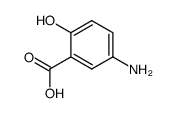5-Aminosalicylic AcidCAS号: 89-57-6分子式: C7H7NO3分子量: 153.14描述纯度储存/保存方法别名外观可溶性/溶解性靶点In vitro(体外研究)In vivo(体内研究)
| 产品描述 | |
| 描述 |
5-Aminosalicylic acid 是一种特异性的 PPARγ 激动剂,还抑制 p21-激活激酶1 (PAK1) 和 NF-κB。 |
| 纯度 |
>98%
|
| 储存/保存方法 |
Store at -20℃ for one year(Powder);Store at 2-4℃ for two weeks;Store at -20℃ for six months after dissolution.
|
| 基本信息 | |
| 别名 |
5-氨基水杨酸;美沙拉嗪;;Mesalamine;5-ASA;Mesalazine
|
| 外观 |
White to gray solid
|
| 可溶性/溶解性 |
DMSO : ≥ 6 mg/mL (39.18 mM)
|
| 生物活性 | |
| 靶点 |
IKK
|
| In vitro(体外研究) |
Mesalamine inhibits the enzyme 3-hydroxysteroid dehydrogenase, involved in the reversible conversion between DHP and THP, and therefore may affect the local actions of DHP and THP in the brain. Mesalamine, an anti-inflammatory aminosalicylate, dose-dependently inhibits IL-1-stimulated NF-kappaB-dependent transcription without preventing IkappaB degradation or nuclear translocation and DNA binding of the transcriptionally active NF-kappaB proteins, RelA, c-Rel, or RelB. Mesalamine is found to inhibit IL-1-stimulated RelA phosphorylation. Mesalamine increases cell adhesion which is measured by cell adhesion assay and transcellular-resistance measurement. Mesalamine treatment restores membranous expression of adhesion molecules E-cadherin and β-catenin. Mesalamine or sulfasalazine (2 mM), but not sulfapyridine, significantly reduces the expression of the TC22 transcript and significantly reduces the expression of TC22 protein in a dose-dependent and reversible manner. Mesalamine induces membranous expression of E-cadherin and increases intercellular adhesion. Mesalamine activity modulates E-cadherin glycosylation and increases both mRNA and protein levels of GnT-III and its activity as detected by increased E4-lectin reactivity. Mesalamine (0.1-1 mM) shows considerable inhibition of peroxynitrite-mediated luminol chemiluminescence in a dose-dependent fashion, suggesting that Mesalamine is able to directly scavenge the peroxynitrite. Mesalamine only at higher concentration (1 mM) inhibits the hydroxyl radical adduct while shifting Electron paramagnetic resonance (EPR) spectra.
|
| In vivo(体内研究) |
5-Aminosalicylic acid (5-ASA) has an antineoplastic effect in a xenograft tumor model. To evaluate the in vivo antineoplasic effect of 5-Aminosalicylic acid, SCID mice engrafted with HT-29 colon cancer cells are treated daily for 21 consecutive days with 5-Aminosalicylic acid at 50 mM. At the end of the treatment, a reduction of 80-86% of tumor weight and volume is observed in SCID mice receiving 5-Aminosalicylic acid compared with control mice or mice treated with GW9662 alone. The antineoplastic effect of 5-Aminosalicylic acid is already detectable after 10 days of 5-Aminosalicylic acid treatment. Similar results are obtained with mice treated with 5-Aminosalicylic acid at 5 mM. Antitumorigenic effect of 5-Aminosalicylic acid is completely abolished at 21 days by simultaneous intraperitoneal administration of GW9662. Thus, the observed antineoplastic effect of 5-Aminosalicylic acid is at least partially dependent on PPARγ.
|
分子结构图

